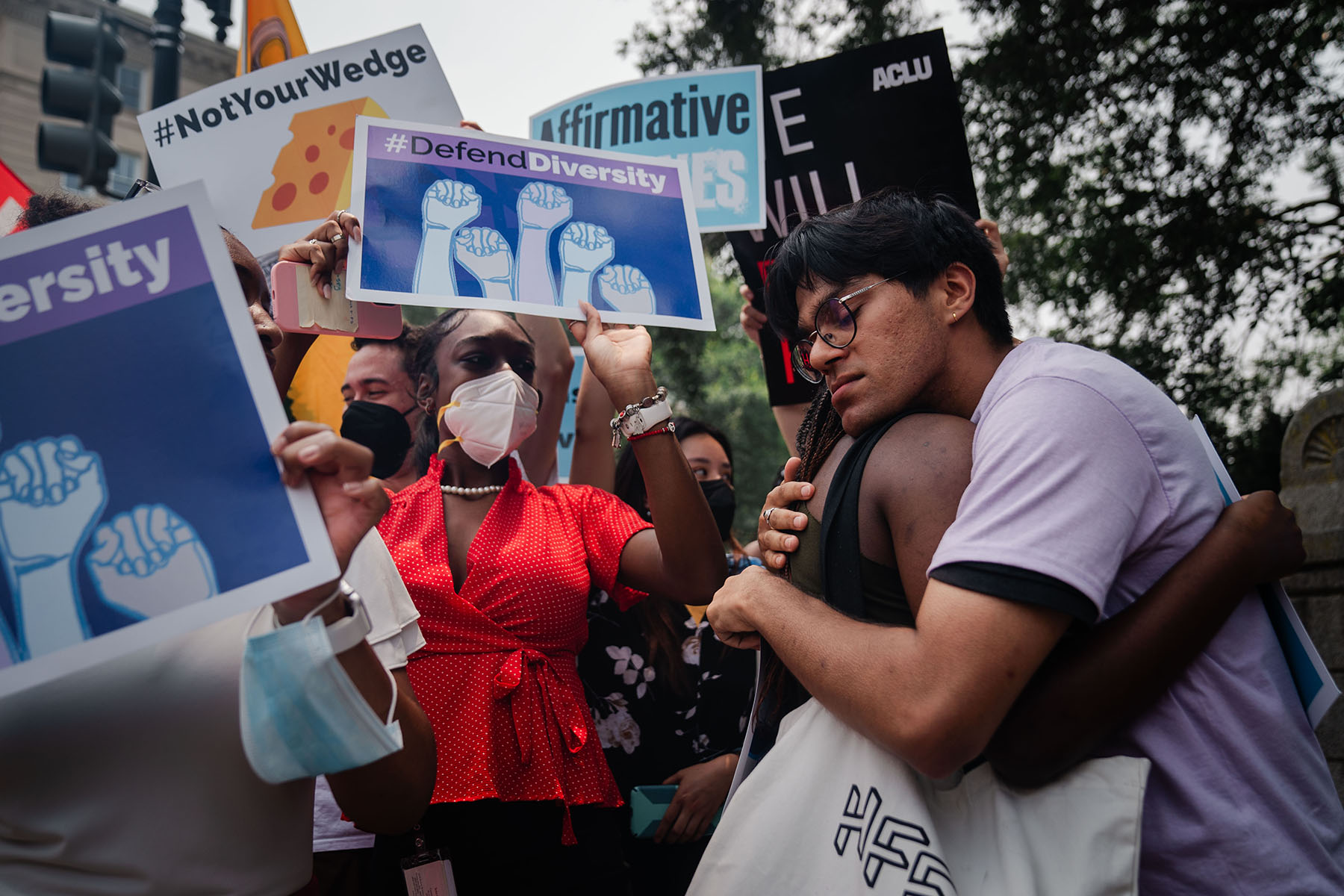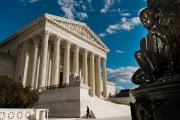How Americans feel about the end of affirmative action in college admissions depends not just on their race but also their age and gender, according to a recent Gallup poll.
Sixty-eight percent of the 12,443 respondents surveyed said they view the Supreme Court’s decision last summer to stop race-conscious college admissions as “mostly a good thing.” That includes 52 percent of Black Americans, the group often at the center of debates on the policy, which was enacted to address the nation’s long history of discrimination. Gallup published the poll in January, having conducted it from October 25 to November 9 with a margin of error of 1.9 percentage points.
Although a slight majority of Black Americans support the Supreme Court’s ruling in Students for Fair Admissions v. Harvard, Gallup found that their views on the ruling differ by age. Fifty-six percent of Black Americans aged 40 and older view the end of race-conscious admissions as “mostly a bad thing,” compared with 38 percent of their counterparts aged 18 to 39. Additionally, more men of color than women in their demographics may fear that the end of affirmative action will have a widely adverse outcome, based on a gender and racial breakdown of respondents Gallup provided exclusively to The 19th.
Thirty-one percent of Black men and 16 percent of Latinx men agree that the policy’s demise will have a “mostly negative impact” on higher education. Twenty-six percent of Black women and 12 percent of Latinas said the same thing. These figures, however, may be within the margin of error, which Gallup noted is higher for subgroups.
-
Previous Coverage:
-
Previous Coverage: The Supreme Court ends affirmative action in college admissions
The results may be unexpected since Black and Latinx women outnumber men in college and older Black Americans haven’t attended college in decades, but experts said that in both cases the lived history of the respondents applies. Older Black Americans link affirmative action to racial progress because they may remember a time without it and when higher education institutions were largely segregated. Men of color may be most concerned about the policy because they faced challenges getting into college that predated the court’s ruling.
“There are folks who responded to the survey who probably experienced a time when there weren’t as large of a percentage as we see today of Black students pursuing higher education and could remember a time when those percentages were in single digits versus maybe those who are younger, who have always been aware of Black college enrollment being in the double digits very close to our proportion in the population overall,” said Camille Lloyd, director for the Gallup Center on Black Voices. “There is a little bit of an experiential factor.”
Danielle Holley, the first Black woman permanently appointed president of Mount Holyoke College and former dean of Howard University Law School, said that many Black baby boomers grew up in the Jim Crow South and remember what it was like when segregation prevented Black students from attending predominantly White institutions (PWIs). They saw affirmative action break down some barriers and fear that without it, people of color won’t have access to the most selective universities. People under 40 have always known a world with affirmative action and can’t recall a time when Black Americans were practically nonexistent at PWIs.
“So many of the things that they experienced they think of as the norm, and they’re not the norm,” Holley said. “The norm was the hundreds of years of racial segregation that kept Black and Brown people out of higher ed. They only see what they’ve experienced, which is a world that’s open to opportunity because of affirmative action.”
Holley also noted that many Gen Xers, the youngest of whom are 44, grew up in a world where affirmative action was prevalent. Since their parents often had direct knowledge of the Jim Crow South, even the young end of that generation understands the stakes involved in ending race-conscious admissions. Black Americans under 40 are more distant from this history.
On the other hand, men of color of all ages may have been more likely to say that the end of affirmative action will have a largely negative impact on higher education because they were already on campuses in small numbers and fear that affirmative action will make college even more inaccessible, Lloyd said. Even at many historically Black colleges and universities (HBCUs), just 1 out of 3 students are men. Overall, 36 percent of Black women have a college degree compared with 27 percent of Black men. Twenty-eight percent of college-age Latinx men are enrolled in a higher education institution, compared with 35 percent of Latinx women; 20 percent of the former have a college degree compared with 27 percent of the latter.
-
Read Next:
-
Read Next: What it takes to defend diversity
Although White women (51 percent) are more likely to graduate from college than White men (44 percent), more women (15 percent) in this racial group than men (12 percent) agree that the end of affirmative action would have a “mostly negative impact” on colleges and universities.
“Affirmative action is what opened the door that benefited everyone, primarily women,” Holley said. “White women especially receive huge benefits from affirmative action.” As recently as the late 1960s and 1970s, many of the nation’s highly selective colleges and universities were only beginning to admit women, with affirmative action used to reach gender diversity.
White Americans overall (72 percent) were the group most likely to agree that the end of affirmative action is a “mostly good thing.” They were followed by Hispanics (68 percent), Asian Americans (63 percent) and Black Americans. Holley said that individuals classified as Hispanic are such a diverse group that views within the demographic may vary widely. Hispanics, for example, can be of any race. Additionally, Latinx people from immigrant backgrounds may not be as familiar with what college life was like before affirmative action.
The fact that Asian Americans (38 percent) were the group second to Black Americans (48 percent) to agree that affirmative action ending was “mostly a bad thing” belies the fact that the two groups have often been pitted against each other in debates about the policy. A majority of White Americans (55 percent) and a plurality of Asian Americans (46 percent) said that affirmative action ending will make no difference to college applicants from their racial group.
In fact, they’re likely correct, Holley said, as they may not have attended highly selective colleges where race-conscious admissions matter most. The majority of Americans of all races do not attend such colleges, she said, but there is a lot to lose if Black and Latinx Americans are shut out of elite institutions.
-
Read Next:
“Those are the spaces that produce most of the leaders of color in our country,” she said. “So when you think of the Obamas, when you think of (former Attorney General) Eric Holder — all of those people, for the most part, went to highly selective colleges and universities. So if you do not have a race-conscious admission system, that bodes very negatively for the Black and Latino communities and for students who want to be able to do things like get judicial clerkships, be judges, be doctors, be lawyers. That is what we’re really talking about is the ability to close economic gaps, to close educational gaps.”
Supreme Court Justice Sonia Sotomayor — who is Puerto Rican and was raised in public housing in the Bronx, New York — has been vocal that affirmative action led to her attending Princeton University and Yale Law School. “I was the perfect affirmative action child,” she told students at Michigan State University in 2018. “Don’t look at how I got in. Look at what I did.”
Holley said that when highly selective colleges no longer reflect the nation’s demographics, perhaps public opinion will shift on affirmative action. Lloyd, for one, said that she thought it was interesting that majorities of respondents from each racial group support the Supreme Court’s decision. This indicates that most of those surveyed believe college admissions should be solely merit-based, she said, but many people also have a poor understanding of what affirmative action is. They may believe, for instance, that it involves the use of racial quotas, which are illegal. They may not understand how historically privileged groups continue to benefit from policies such as legacy admissions, a practice that favors applicants who are the relatives of alumni.
For the next stage of research, Lloyd wants to examine how attitudes on affirmative action affect the decisions people make about college in the near future.
“How many individuals are going to make a decision not to pursue higher education because they perceive it to not be accessible to them?” Lloyd asked. “I think that the next research question is to understand how people are changing their decisions as a result of what they perceive from this ruling.”









